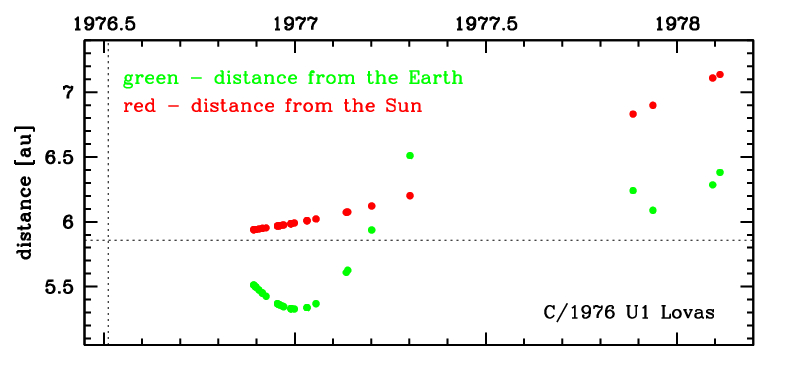C/1976 U1 Lovas
more info
Comet C/1976 U1 was discovered on 27 October 1976, 3.7 months after its perihelion passage, and was last seen on 10 February 1978 [Kronk and Meyer, Cometography: Volume 5].
This comet made its closest approach to the Earth on 1 January 1977 (5.33 au), about 2 months after its discovery.
Solution given here is based on data spanning over 1.22 yr in a range of heliocentric distances from 5.94 au to 7.14 au.
This Oort spike comet suffers small planetary perturbations during its passage through the planetary system that lead to a more tight future orbit (see future barycentric orbit).
See also Królikowska 2014 and Królikowska and Dybczyński 2017.
This comet made its closest approach to the Earth on 1 January 1977 (5.33 au), about 2 months after its discovery.
Solution given here is based on data spanning over 1.22 yr in a range of heliocentric distances from 5.94 au to 7.14 au.
This Oort spike comet suffers small planetary perturbations during its passage through the planetary system that lead to a more tight future orbit (see future barycentric orbit).
See also Królikowska 2014 and Królikowska and Dybczyński 2017.
| solution description | ||
|---|---|---|
| number of observations | 30 | |
| data interval | 1976 11 22 – 1978 02 10 | |
| data type | observed only after perihelion (POST) | |
| data arc selection | entire data set (STD) | |
| range of heliocentric distances | 5.94 au – 7.14au | |
| detectability of NG effects in the comet's motion | NG effects not determinable | |
| type of model of motion | GR - gravitational orbit | |
| data weighting | NO | |
| number of residuals | 60 | |
| RMS [arcseconds] | 1.69 | |
| orbit quality class | 1b | |
| previous orbit statistics, both Galactic and stellar perturbations were taken into account | ||
|---|---|---|
| no. of returning VCs in the swarm | 4647 | * |
| no. of escaping VCs in the swarm | 354 | |
| no. of hyperbolas among escaping VCs in the swarm | 76 | |
| previous reciprocal semi-major axis [10-6 au-1] | 23.87 – 41.31 – 74.85 | R |
| previous perihelion distance [au] | 5.3 – 430 – 2800 | R |
| previous aphelion distance [103 au] | 27 – 48 – 81 | R |
| time interval to previous perihelion [Myr] | 1.5 – 3.1 – 7.6 | R |
| percentage of VCs with qprev < 10 | 37 | |
| percentage of VCs with qprev > 20 | 63 | |
| previous_g orbit statistics, here only the Galactic tide has been included | ||
|---|---|---|
| no. of returning VCs in the swarm | 4557 | * |
| no. of escaping VCs in the swarm | 444 | |
| no. of hyperbolas among escaping VCs in the swarm | 81 | |
| previous reciprocal semi-major axis [10-6 au-1] | 25.47 – 47.84 – 74.89 | R |
| previous perihelion distance [au] | 5.34 – 5.63 – 56.9 | R |
| previous aphelion distance [103 au] | 27 – 42 – 78 | R |
| time interval to previous perihelion [Myr] | 1.5 – 3 – 7.6 | R |
| percentage of VCs with qprev < 10 | 75 | |
| percentage of VCs with 10 < qprev < 20 | 8 | |
| percentage of VCs with qprev > 20 | 17 | |
